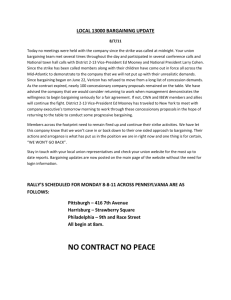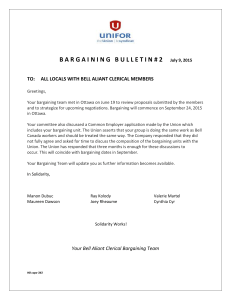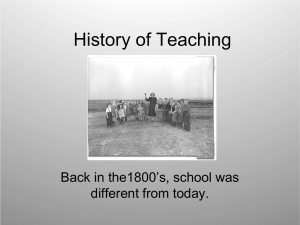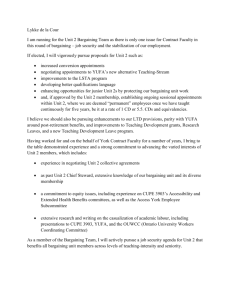T015-Solutions
advertisement
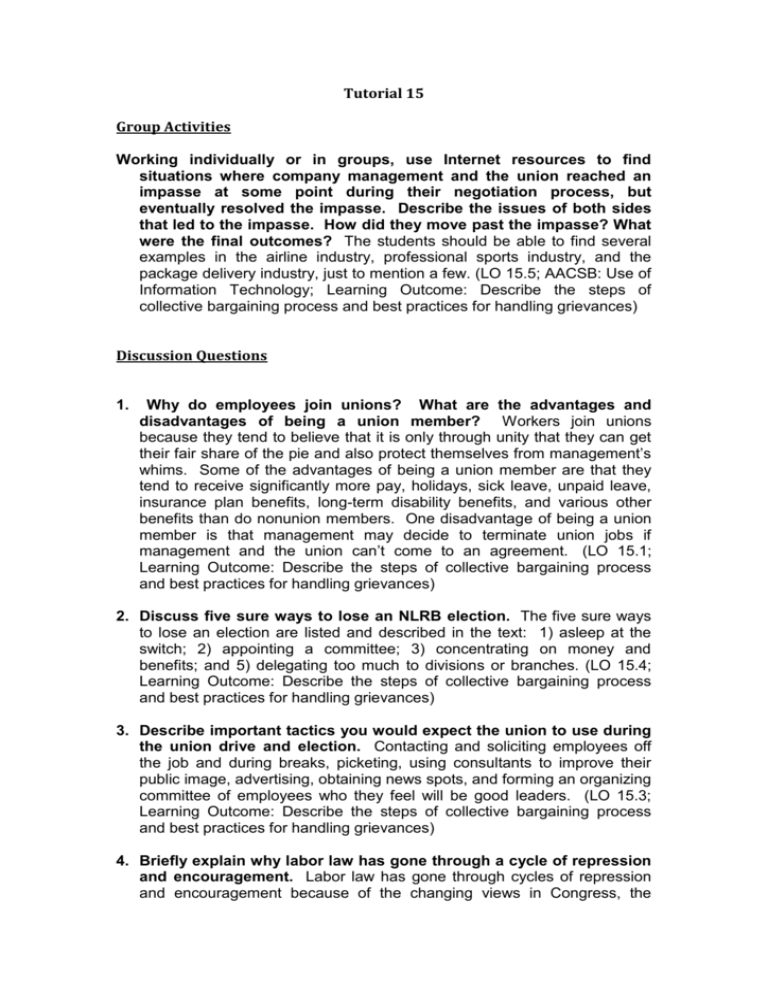
Tutorial 15 Group Activities Working individually or in groups, use Internet resources to find situations where company management and the union reached an impasse at some point during their negotiation process, but eventually resolved the impasse. Describe the issues of both sides that led to the impasse. How did they move past the impasse? What were the final outcomes? The students should be able to find several examples in the airline industry, professional sports industry, and the package delivery industry, just to mention a few. (LO 15.5; AACSB: Use of Information Technology; Learning Outcome: Describe the steps of collective bargaining process and best practices for handling grievances) Discussion Questions 1. Why do employees join unions? What are the advantages and disadvantages of being a union member? Workers join unions because they tend to believe that it is only through unity that they can get their fair share of the pie and also protect themselves from management’s whims. Some of the advantages of being a union member are that they tend to receive significantly more pay, holidays, sick leave, unpaid leave, insurance plan benefits, long-term disability benefits, and various other benefits than do nonunion members. One disadvantage of being a union member is that management may decide to terminate union jobs if management and the union can’t come to an agreement. (LO 15.1; Learning Outcome: Describe the steps of collective bargaining process and best practices for handling grievances) 2. Discuss five sure ways to lose an NLRB election. The five sure ways to lose an election are listed and described in the text: 1) asleep at the switch; 2) appointing a committee; 3) concentrating on money and benefits; and 5) delegating too much to divisions or branches. (LO 15.4; Learning Outcome: Describe the steps of collective bargaining process and best practices for handling grievances) 3. Describe important tactics you would expect the union to use during the union drive and election. Contacting and soliciting employees off the job and during breaks, picketing, using consultants to improve their public image, advertising, obtaining news spots, and forming an organizing committee of employees who they feel will be good leaders. (LO 15.3; Learning Outcome: Describe the steps of collective bargaining process and best practices for handling grievances) 4. Briefly explain why labor law has gone through a cycle of repression and encouragement. Labor law has gone through cycles of repression and encouragement because of the changing views in Congress, the public, and the judiciary on the extent to which legalized collective bargaining is deemed to be a good approach to the economic situation facing the country as well as the views of personal and corporate rights. Changing public attitudes, values, and economic conditions clearly impact labor law, just as they impact law in every area. (LO 15.1; AACSB: Analytic Skills; Learning Outcome: Describe the steps of collective bargaining process and best practices for handling grievances) 5. Explain in detail each step in a union drive and election. Each step is described in detail in the text: 1) initial contact involves the union determination of the employees' interest in organizing and forming an organizing committee; 2) obtaining authorization cards is where the union seeks to obtain enough signatures on authorization cards to petition the NLRB to conduct an election; 3) holding a hearing is done by the NLRB to determine the appropriate bargaining unit and the legality of the authorization cards; 4) the campaign is where both sides present the issues to convince employees to vote one way or the other; and 5) the election is conducted by the NLRB through secret ballot. (LO 15.3; Learning Outcome: Describe the steps of collective bargaining process and best practices for handling grievances) 6. What is meant by good faith bargaining? Using examples, explain when bargaining is not in good faith? Good faith bargaining means that both parties are communicating and negotiating and proposals are being matched with counterproposals with both parties making every reasonable effort to arrive at agreements. Examples of violations of good faith bargaining include: surface bargaining; inadequate concessions; inadequate proposals and demands; dilatory tactics; imposing conditions; making unilateral changes in conditions; bypassing the representative; committing unfair labor practices during negotiations; withholding information; and ignoring bargaining items. (LO 15.5; Learning Outcome: Describe the steps of collective bargaining process and best practices for handling grievances) 7. Define impasse, mediation, and strike, and explain the techniques that are used to overcome an impasse. Impasse occurs when the parties are not able to move further toward settlement. Mediation is intervention in which a neutral third party tries to assist the principals in reaching agreement. A strike is the withdrawal of labor. An impasse might be overcome through mediation, fact-finders, arbitration, or the economic pressures of a strike or lock-out. (LO 15.5; AACSB: Learning Outcome: Describe the steps of collective bargaining process and best practices for handling grievances)

![Labor Management Relations [Opens in New Window]](http://s3.studylib.net/store/data/006750373_1-d299a6861c58d67d0e98709a44e4f857-300x300.png)

